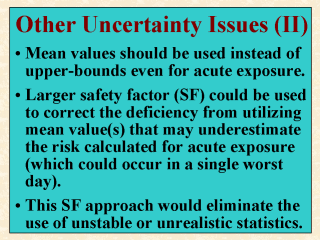 |
In most cases,
even for acute exposure, average values should be used instead of upper-bounds, in that
the sample mean is typically more stable and hence more reliable than the extreme values.
It is based on this assertion that the use of 99.9th percentile exposure for the acute
dietary intake assessment is deemed unnecessary. Although a 95th percentile apparently
would leave about 5% of a very large population unprotected, the variable value associated
with the 99.9th percentile could be many times higher than necessary. If the value of the
99.9th percentile is not more than 2 or 3 times greater than that of the 95th or of the
50th percentile, then by default the uncertainty factor (UF) of 10 for intraspecies
sensitivity should be sufficient to protect all people in the population. If the actual
99.9th percentile is indeed orders of magnitude greater than the 95th percentile, then
perhaps regulatory agencies need to think twice before limiting the UF to 10 for
intraspecies sensitivity. For acute exposure when a person could receive a single
upper-end dose, the use of the mean value alone would certainly underestimate the exposure
at issue. The simplest solution to this deficiency is to increase the overall safety
factor (i.e., the product of several UF) that goes into the calculation of the ADI
(acceptable daily intake) or the RfD (reference dose), by a fixed value of 3, 5, or even
10. This approach would eliminate a great deal of uncertainties with the use of some
statistics that are often based on sparse or otherwise inadequate data, and certainly
would reduce a great deal of grieves and frustration from exposure assessors in resolving
these uncertainties. |
